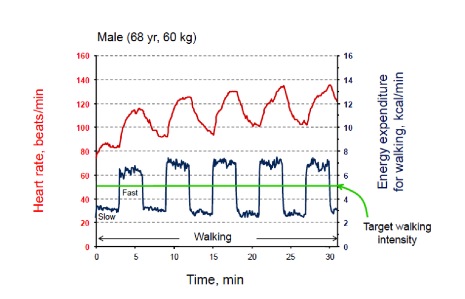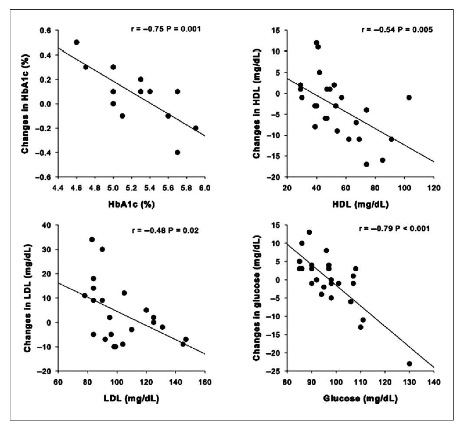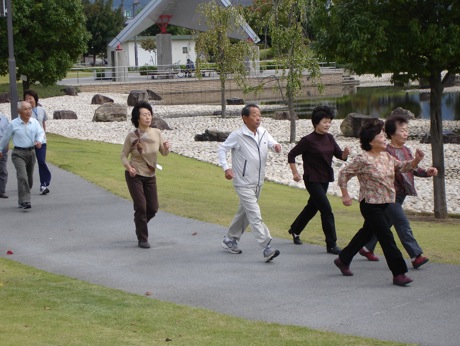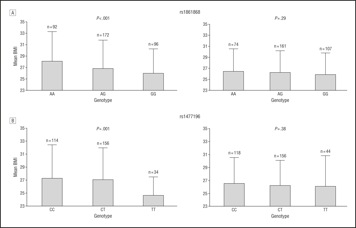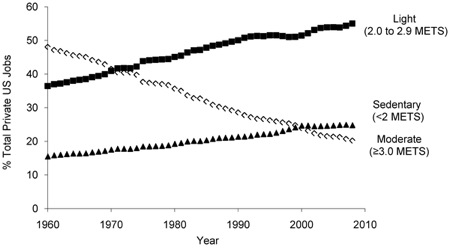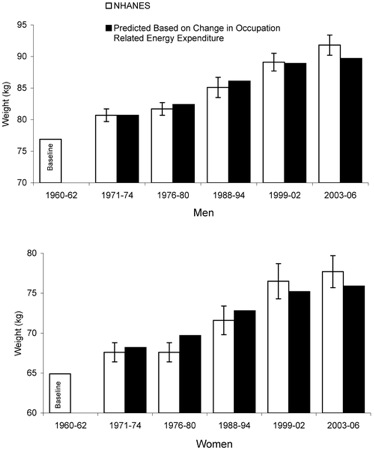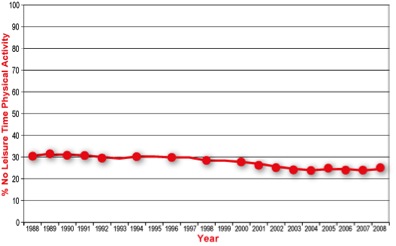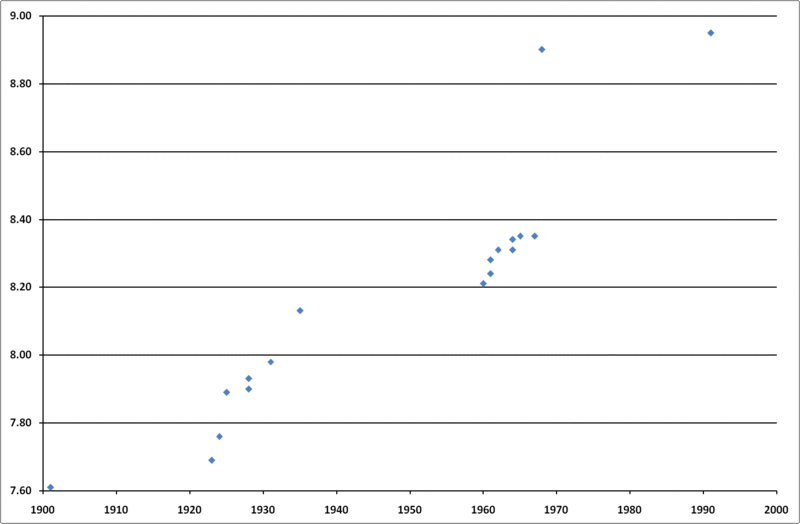Archive for the ‘Physiology’ Category
Live Long and Prosper!
For the last month or so I have been focused on the twin problems of inactivity and obesity. Today I want to turn the tables on these problems and ask what we know about people who live a long time and remain independent.
It turns out a lot is known about who makes it into their later 80s, 90s or 100. In other words who lives a long time and remains independent and engaged in life One of the first people to study this topic was Dr. Lester Breslow who died earlier this year at age 97. His obituary in the Lancet pointed out that he was a pioneer in public health showing that:
“45-year-olds who adopted six healthy habits—exercise, non-smoking, weight control, adequate sleep, moderation in alcohol use, and breakfasting well—lived longer than people with three or fewer healthy habits.”
Midlife fitness is also important because it reduces the burden of chronic disease as people age and limits the slow drift into disability and functional limitations seen in many older people. So if you want to be a vigorous older person, be a vigorous middle-aged person.
One of the most interesting studies on this topic comes from the Honolulu Heart Project that has followed about 8,000 Japanese American males born in the early 1900s. The study started in the middle 60s and has found that only a couple of factors explain who lives a long time and who remains healthy. Recently the more than 2,000 men who are still alive were studied and it was found that:
“Compared with people who died at the age of ≤79 years, centenarians belonged 2.5 times more often to the highest third of grip strength in midlife, were never smokers, had participated in physical activity outside work, and had a long-lived mother (≥80) Associations for nonagenarians (90 year olds) and octogenarians (80 year olds) were parallel, but weaker. Statistical modeling showed that mother’s longevity and offspring’s grip strength operated through the same or overlapping pathway to longevity. High midlife grip strength and long-lived mother may indicate resilience to aging, which, combined with healthy lifestyle, increases the probability of extreme longevity.”
Clearly we can’t pick our mothers, but we can chose not to smoke and to remain physically active. Studies of the Seventh Day Adventists in California who have incorporated the ideas outlined above also live long lives and remain independent into old age. The slide below show that Adventist men live about 7-8 years longer than other men in California, for women it was about 4-5 years. About 70% of Adventists men make to age 80 but only 40% of the male population as a whole makes it to age 80.
Summary: Dr. Breslow was right a few simple behaviors can have a big impact on both how long we live and how well we live.
Interval Walking Training
In several recent posts I have focused on physical activity and health and also the link between obesity and inactivity. Not a lot of good news if you look at the population statistics, but good news if you think about just how protective exercise and physical activity are both in terms of obesity and also general health. So, what to do about it?
Perhaps the easiest, cheapest and most convenient form of exercise for most people, especially middle aged (40-65) and older (>65) people is simply walking. One of the best and most effective ways to get the most out of your walking is to do something called Interval Walking Training (IWT). This program was developed in the Japan by my close friend and colleague Hiroshi Nose, and his research team to help thousands of people get into better shape.
The idea is to use the same principles that elite endurance athletes and Olympians do when you go for a walk. To get in the best shape possible the elites do work outs that include multiple 3-5 minute efforts that are nearly all out followed by 2-3 minutes of recovery several times or more per week. Both scientific studies and practical experience suggests that this is a key to getting in the best possible shape. It also gives you incredible “bang for the buck” in terms of time, and what works for the elite athletes can work for us all.
The IWT program consists of 5 or more sets of 3 minutes of low-intensity walking followed by fast walking for 3 minutes four or five times per week. Low intensity walking should be a bit faster than a stroll (40% effort) and higher intensity walking should be at greater than 70% of maximum effort. Hiroshi’s team has used this approach in a number of their studies and they use heart rate monitors and tracking devices called accelerometers to set and measure exercise intensity.
The figure below is one that shows a typical heart rate response and calorie consumption pattern with this type of training in one of the subjects in Japan. It was sent to me by Dr. Shizue Masuki and the data was collected by Dr. Ken Miyagawa, they are both key members of the Nose team. Hiroshi had the following comments about the data:
“As shown in the figure, HR increases to ~130 beats/min during fast walking, but decreases during slow walking, This slow walking or recovery period is important because it motivates a subject to walk at high intensity again. Moreover, because the interval walking training was performed in a hot environment (atmospheric temperature=32 C, RH=60%), HR level increases with increasing body temperature, which makes it difficult to estimate walking intensity from HR accurately. Therefore, it is important to monitor walking intensity with a tri-axial accelerometer.”
Does this work? To quote one of the early papers on IWT:
“In the IWT group, isometric knee extension increased by 13%, isometric knee flexion by 17%, peak aerobic capacity for cycling by 8%, and peak aerobic capacity for walking by 9%, all of which were significantly greater than the increases observed in the moderate-intensity continuous walking training group. Moreover, the reduction in resting systolic blood pressure was higher for the high-intensity interval walking training group.”
Below is a figure from a collaborative study that we did with the team from Japan. It shows what happens to selected inactivity associated risk factors when 26 previously sedentary people (average age 54) followed the program about four days per week for three months. The people with the worst initial values for HbA1c (a diabetes related marker), HDL cholesterol, LDL cholesterol and glucose showed the biggest improvements with IWT. We also found big increases in exercise capacity and reductions in blood pressure. So, it worked!
In an article in the New York Times on what the best form of exercise Professor Nose put what IWT can do for people in laymen’s terms.
“Physical fitness — maximal aerobic power and thigh muscle strength — increased by about 20 percent which is sure to make you feel about 10 years younger than before training…….symptoms of lifestyle-related diseases (hypertension, hyperglycemia and obesity) decreased by about 20 percent, and depression scores dropped by half.”
I am closing with a shot of a beautiful park in Matsumoto, Japan where the Nose team is located and where many of the subjects he studies do their walking.
Inactivity and Obesity
This post is on how inactivity is a major player in the obesity epidemic. It is data rich so fasten your seat belts. That having been said, I want to make three main points:
- Physical inactivity is an extremely recent experience for humans as a species.
- People with high levels of physical activity are protected from obesity.
- A loss of physical activity at work as we all become desk jockeys is a big reason why we are getting fatter as a population.
Inactivity is recent.
Dates vary but modern humans emerged out of Africa and began to spread to the rest of the world about 40,000 years ago. For the next 30,000 years essentially we were all hunter gatherers. Based on a variety of estimates, including observations in the few remaining hunter gatherer societies, it appears that many adults hunter gatherers walk between 10 and 20km (6-12 miles) per day. There also appears to be essentially no obesity in these societies. There are complex potential interactions between their activity levels and what they were eating, but many groups of hunter gatherers had access to plenty of food. Granted the variety might have been minimal, but for many there were plenty of calories.
About 10,000 years ago agriculture emerged during something called the Neolithic Revolution. We have at least some idea about the activity levels associated with muscle power (human or draft animal) farming from the Old Order Amish who practice agriculture without the benefit of electricity or tractors but do use horses! It is also pretty clear that they eat an awfully lot of what could be called traditional high calorie farm food. Here is a quote from adapted a classic study on the Old Order Amish.
“The average number of steps per day was 18,425 for men versus 14,196 for women. Men reported 10.0 hours per week of vigorous physical activity, 42.8 hours per week of moderate physical activity, and 12.0 hours per week of walking. Women reported 3.4 hours per week of vigorous physical activity, 39.2 hours per week of moderate physical activity, and 5.7 hours per week of walking. Men had higher levels of energy expenditure than women. A total of 25% of the men and 27% of the women were overweight (BMI > or = 25), and 0% of the men and 9% of the women were obese (BMI > or = 30).”
High levels of physical activity protect against obesity.
The data above mean that most Old Order Amish are essentially physically active all day long most days. Contrast their BMI values with the values for the U.S. population as a whole that I reviewed earlier this week, 35% obese and 60-70% overweight. Another interesting thing about the Old Order Amish is that their high levels of activity protect them from two gene variants that seem to predispose sedentary people to higher BMIs. The left panels on the figure below show that for Old Order Amish in the bottom 50% of physical activity there is a relationship between the gene variants and BMI. The right panels show that for those in the top 50% of physical activity there is no relationship between the gene variants and BMI. Genetic predispositions get blamed for all sorts of things but the environment, culture and lifestyle typically has an even bigger role for most common conditions. Again high levels of physical activity are protective against obesity.
Physical activity at work matters.
The Old Order Amish are people who are clearly active all day long with farming and household chores. They are probably as active or even more active than hunter gatherers were. However, in the last hundred years a muscle powered way of life has vanished for most of us. So, what about the rest of us? It turns out that over the last 50-100 years most of us are doing less and les physical activity at work. The slide below is from a terrific scientific paper on this topic. It shows that as over the last 50 years the number of people employed in jobs associated with moderate physical activity has declined from about 50% to 20%. As the authors note:
“From 1960 to 2008 there was an approximate drop in occupation-related daily energy expenditure of 140 calories for men and 124 calories for women.”
For most of us that is like walking (or not walking) 1 to 1.5 miles during the day. What is even more amazing is how these missing calories add up and explain population based weight gain over the last 40 or 50 years. The figure below also from this paper shows the impact of the missing calories on estimated changes in body weight over time and how the match up with the NHANES population surveys in the U.S. It is incredible how well the numbers match up. It is also incredible what a big impact just over 100 hundred calories a day has.
Summary
Hunter gatherers and traditional farmers were very active and almost none were fat even when there was plenty of food around. However, you don’t have to be that active to avoid the being a statistic in the current obesity epidemic. The data on occupational energy expenditure from the last 50 years shows that burning an extra 100-150 calories a day can have a huge impact on population based body weight statistics. From a practical perspective what would happen if everyone went for a brisk 20-30 minute walk at lunch every day?
Physical Activity: Are We Getting Enough?
A couple of days ago I discussed whether deconditioning should become a distinct medical diagnosis because it is the root cause of so many devastating chronic diseases. In this short post I want to briefly review how much structured exercise or physical activity is enough and whether people are getting enough?
First, let me briefly comment on exercise and physical activity. They are related but not exactly the same thing. Structured exercise includes things like going to the gym, playing in a sports league of some type, or a planned walk or run. In general, anything that is organized and designed as a workout. Physical activity is a broader way to look at things. In addition to formal exercise, it includes things like riding your bike to work, taking the stairs, household chores, unstructured play and other recreational activities.
Second, what are the guidelines? I am attaching a link to the most recent U.S. guidelines for physical activity. They are designed to prevent the development of many of the chronic conditions that result from inactivity. The key numbers are:
“Adults (18-64) should do 2 hours and 30 minutes a week of moderate-intensity, or 1 hour and 15 minutes (75 minutes) a week of vigorous-intensity aerobic physical activity, or an equivalent combination of moderate- and vigorous-intensity aerobic physical activity. Aerobic activity should be performed in episodes of at least 10 minutes, preferably spread throughout the week.”
There are other ideas and numbers out there, but when you look at them in detail most are pretty similar. The guidelines also include specific recommendations for children and older adults along with ideas about strength training.
Third, how is the population doing as a whole in meeting these guidelines? The short answer is terrible. The next link is to a paper that used accelerometers to measure physical activity as part of the NHANES study and the bottom line is that:
“Among adults, adherence to the recommendation to obtain 30 minutes per day of physical activity is less than 5%.”
Fourth, the chart below from the U.S. Centers for Disease Control shows just how many people get no leisure time physical activity at all. Things appear to be getting a bit better over the last 10 years, but 25% of people are completely inactive and as we saw in the chart from a couple days ago, the biggest improvements in health occur when people go from being completely inactive to doing something.
These statistics are a snapshot of just how bad things are. In my next few posts I am going review how much physical activity is “normal” for humans and what can be done about this huge problem. There are many innovative solutions that are working out in the real world, so there is no need to “sit around” and wait for them to happen.
Olympics: Catching my breath
After yesterday’s long post on the East Africans, I want to catch up on a couple of things.
The home field advantage and the medal count.
I received a comment on the home field advantage and the impressive performance of U.K. athletes from Amby Burfoot of Runner’s World fame. Amby is also interested in what the Galen Rupp silver in the 10,000m means for U.S. distance running. Here is a link to Amby’s outstanding post on this topic.
About the home field advantage, he noted that the games are awarded years in advance and that as a result countries invest in better facilities and preparation. Plus getting the games is a big motivator for young athletes. Good points all. One example is the case of Australia, a country that generally ranks highly in the per capita count. They got a big bump in 2000 at Sydney but their commitment started decades earlier. This link is to the history of the Australian Institute of Sport which took off after a poor showing by Australia in 1976. It describes the comprehensive strategy used “down under” to increase the medal count. Another strategy is to focus on sports where the medal count return on investment can be high. The U.K has done this in cycling.
Why is the long jump “getting worse”?
The Olympic record in the long jump dates to 1968 when Bob Beamon jumped 8.9m and broke the world record by 55cm (nearly 2 ft). However, as the wikicommons graph below shows, there have been big increments in the record before followed by periods of stagnation. Jesse Owens set a record in 1935 that lasted 25 years and Beamon’s mark stood until the early 1990s when the current record was set by Mike Powell. The women’s mark (like a lot of women’s records) dates from the 1980s.
If graph does not appear, click here.
The last really consistent great jumper was Carl Lewis who at age 35 won his 4th gold medal in Atlanta. There is also an urban legend about a 30 foot jump by Lewis in Indianapolis in the early 1980s, but a bad call was made and the jump ruled a foul.
I don’t have an explanation for why long jumping has stalled out, but in the case of both Owens and Lewis they were also great sprinters. Perhaps in the era of big money track and field those with the talent to compete in the sprints stick with the sprints, thus limiting the talent pool in the less glamorous long jump. The other obvious explanation, at least in the U.S., is that kids who can jump tend to focus on basketball.
Katie Ledecky vs. Ye Shiwen.
At least one media outlet in the U.K. questioned the big drops in time Katie Ledecky made on her way to gold in the 800m freestyle, and played the doping card. The suspicions voiced in the U.S. swimming community about 16 year old Ye Shiwen’s world record swim in the 400m IM and also raised the issue of a double standard and even racism. Was Ye singled out? In both cases we should all remember that big drops are not unusual for swimmers in this age group. The Chinese should also remember their history of organized doping in swimming and understand that it was not so much Ye Shiwen’s overall time as it was the impressive speed of her last 100m that raised eyebrows.
What I am wondering about.
Jamaica has done well in the sprints since 1948, and other Caribbean countries have also had medalists. However, this year the Caribbean sprinters seem to be more competitive than ever and from more of the islands than ever. In the next couple of Olympics will we see a tidal wave of islanders? When we look back in four or eight or twelve years will we say that Bolt turned on the whole region?
Who Will Beat the Kenyans?
Way to go Mo and Galen!
On Saturday, Mo Farah of Great Britain and Galen Rupp of the U.S. broke the East African monopoly on the 10,000m by winning gold and silver respectively. Their performances raise the general question of “who will beat the Kenyans?” The short answer to this is the Ethiopians who have shared in this dominance since both countries emerged as distance running powers in the 1960s. But is what happened in London the start of something new?
Farah was born in Somalia and immigrated to the U.K. as a child, so I want to focus on Rupp who is white kid from Oregon and the first U.S. athlete to medal in the 10,000m since Billy Mills in 1964. Rupp is also a product of the NIKE sponsored “Oregon Project” which seeks to develop U.S. talent in distance running to compete with the East Africans. Directed by Alberto Salazar, the idea is to nurture selected people in a controlled and scientific way to combat the hordes of East Africans who seek to use running as a means of very basic economic advancement.
This has happened before.
The first thing that needs to be appreciated is that since reliable world records started to be kept in the early 1900s, there have been three periods of regional dominance in distance running. A good example is seen in the world record progression for the 10,000m for men. It shows that runners from Finland held every world record from 1912-1944. From 1949-1962, the Eastern Europeans held 9 of 10 records. Since 1977, East Africans are 11 for 14. Currently runners from Kenya and Ethiopia dominate the list of 25 fastest times for the event and have won the vast majority of Olympic medals in the 10,000m since 1968.
It is hard to compare eras for a number of reasons, but the old days were dominated by archaic amateur rules, limited high quality competition, and later the Cold War. However, I want everyone to realize that there is nothing new about regional dominance in selected track and field events.
Is there anything “special” about the East Africans?
To answer this question we need to take a quick look into the physiology of what makes an elite distance runner. There are three factors critical for success, they include:
- VO2 max, or maximal oxygen uptake. This is essentially how big the engine is.
- The so-called lactate threshold. This sets what might be called a physiological “red-line”.
- Running economy or efficiency. How much oxygen is used to go how fast?
The idea is that VO2 max sets an upper limit and the fraction of VO2 max that can be sustained in competition is related to the lactate threshold. If you know these two values they tell you how much energy a given runner can use for over a given period of time. If you know running economy you can make a pretty good guess of the speed that can be generated with that energy. In a couple of scientific papers, my colleagues and I have explored these concepts in detail. We have focused on the marathon, but the principles also apply to the 10,000m.
So, do the East Africans have exceptional values for any of these factors? A careful review of the scientific studies shows that their values are nothing special for elite distance runners. However, many do have outstanding values for running economy, but these values are not better than those seen in the most efficient whites. Also, no genetic factors have been identified to explain their success.
There is an important caveat here. A time of 26:40 for 10,000m is 1600 seconds. A one percent margin would be 16 seconds, or about 100m on the track in a real competition, which would equal a big win. One percent is also within in the limits of the measurements we can make in the lab that are related to real performance in real competitions. So, it is possible to determine who is world class in the lab, but very difficult to slice it any thinner than that.
If the East Africans have something special it is likely due to hard and active lives at high altitude from an early age. A typical story is the one I heard from my college teammate Harrison Koroso from Kenya. He described, beginning at age 8, running two miles to school, coming home for lunch, running back, and playing soccer for fun; all of this at 7-8,000 feet. The highlands of Kenya are also likely to be pretty free of video games and carpools to play dates.
My main conclusion is that there is way more to the East African success than some physiological secret sauce. In fact there is no physiological secret sauce. I did not go into it here, but there are no secret innovative training techniques either. Top runners have been training essentially as “hard as you can” since the 1950s or early 1960s.
Plenty of talent in the U.S.?
I also want to argue that there is in fact plenty of talent in the U.S. If you look at the all time U.S. high school lists they are pretty impressive. What is also impressive is the number of people on these lists that either faded and never became world class, or became world class but for whatever reason never medaled in Olympic competition. The video clip at the end of the post is of Jim Ryun setting a world record for the mile in 1967 when he was 20 years old. His 3:51:1 on a dirt track would be perhaps 6-7 seconds faster on a synthetic track and close to the current world record. He also ran this fast with no pace maker or rabbit.
Ryun did medal; he got silver in the 1968 games at Mexico City, which is about 7,000 feet high. He was coming back from mononucleosis and defeated by Kip Keino of Kenya. Keino ran an Olympic record 3:34.91, a remarkable time at high altitude. Ryun was tripped in 1972 and failed to advance and his career was over at 25. Rupp is 26, how would Ryun have faired in the corporate sponsored environment Rupp has?
When you get past the top 10 lists, most people connected to the running subculture in the U.S. know stories about the kid who ran a 4:15 mile in high school with minimal training and never pursued it much further. We have also heard stories about the kid who was good but not great in high school and blossomed later. If this talent were harvested and nurtured in the way the Rupp’s has been, what would be the result?
My conclusion here is that there is more than enough talent in the U.S., some of it actually gets identified but what happens after high school is a crapshoot. There are about 120 million people living in Ethiopia and Kenya combined and the good runners come from selected ethnic subgroups. With more than 300 million people, there has to be sufficient talent in the U.S. to challenge the East Africans.
Return on investment thinking and who does what.
Per capita income in Kenya is about $800 per year and about $400 per year in Ethiopia according to the World Bank. Become a good runner, place highly in a few major races and you can feed yourself and extended family for a long time. If you become truly elite, you are wealthy. You don’t have to have a Ph.D. in behavioral economics to understand that kind of motivation in poor societies. If every kid with a shred of talent in the distance running areas of East Africa goes for it, what emerges from the competitive crucible is sure to be exceptional.
What would the equivalent of a $10,000 purse at a midlevel race be in western terms? How many kids would keep running if the there was a distance running circuit with prize money on the order of that seen in the professional golf? I don’t know but I bet it would be plenty.
A flip side of the coin is the recent example is Lukas Verzbicas, who is on several of the top 10 lists for U.S. high school runners. He is also superb at the triathlon and has more or less opted out of running (he had a scholarship at the U of Oregon, a perennial power) to focus on the triathlon. The speculation is the path to the top is less competitive in the triathlon and fame and glory (and perhaps money) more certain.
Summary
In this post I have argued that the primary factors responsible for East African dominance in distance running are cultural and economic. The evidence for an explanation based on physiology, training, or genetics is pretty thin. Is Rupp a one off, or will his impressive performance be catalytic like Greg LeMond’s victories in the Tour de France were? LeMond won the Tour in 1986. He came back from a life threatening hunting accident to win again in the 1989 and 1990. His victories and courage broke the myth of European superiority in cycling and opened the way for competitors from all over the world.
Women outnumber men in 2012 Olympics – KARE 11
I was on KARE-11 on Saturday morning sharing thoughts on women in the Olympics and tips for the general public to get started on their own athletic endeavors. Click here to see the live segment.
The Olympics: Questions From Bill K
I had an e-mail exchange with Bill Katovsky yesterday that raised a couple of interesting questions about things that have happened at the Olympics over the last couple of days. Bill has written a number fitness and training oriented books, most recently one on minimalist footwear and injury prevention. Here is a brief summary of two questions from Bill.
1) Great Britain seems to be doing very well the last couple of days in the medals count. Is there a home field advantage?
When I looked this morning the Brits stood third after the US and China who were tied for first. There is an excellent graphic from 2008 in the New York Times that explores medals by country over the years. It looks like the home field advantage is substantial. Australia for example went from 41 total medals in 1996 to 58 in 2000 when the Olympics were in Sydney. In 2004 and 2008 they were back in the 40s.
2) About Katie Ledecky, the 15 year old who won the 800m freestyle swim. Bill asks, “How can someone that young win, and win by a lot — she set an American record– in an endurance race like the 800m. Can you imagine a 15-year boy winning the 800m in track? Why in swimming, and why with women?
There is long history of girls in this age group doing incredibly well in Olympic swimming. The wiki link to the 800m record progression (scroll down to get the women’s list) shows a number of outstanding examples including Shane Gould, Debbie Meyer, and Janet Evans. They were all 15 or 16 when they set records in the 800m.
Swimming is different than running. By the time many outstanding swimmers are in their early teens they are training extremely hard by adult standards, and many have been training hard for five plus years. There is less orthopedic stress in swimming, in other words no pounding, so kids in this age group can handle high training loads with less risk of injury. For so-called aerobic sports (distance swimming, running, cycling), swimming is the most technique driven. So it is possible for a young swimmer to be both really fit and have the technique needed to win at a young age.
Teenage girls have done well in all sorts of sports for a long time (think tennis and golf), and the other issue in swimming and endurance sports is that there may be a body composition sweet spot where muscle mass is high but before the adult “curves” emerge.
Bill and I discussed some other issues like a white athlete winning the long jump, and a non Kenyan/Ethiopian winning the men’s 10,000m with American Galen Rupp getting the silver. I will save these topics for later because each deserves a longer post with more on the background physiology and sociology behind them.
You are currently browsing the archives for the Physiology category.



